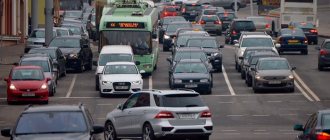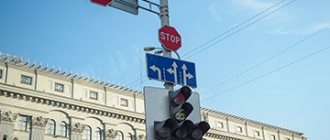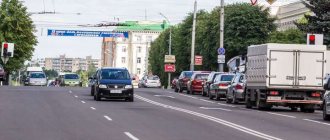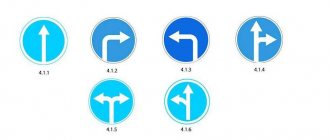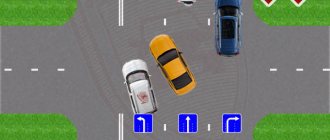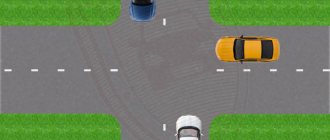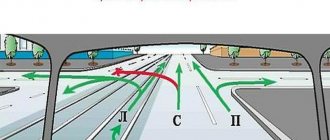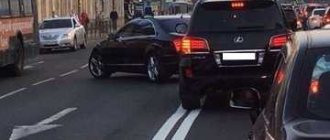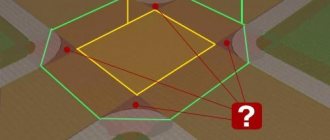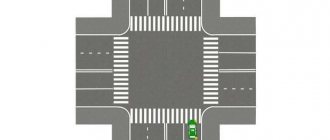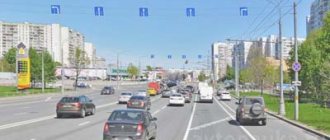There are rules that the driver does not use every day, for example, traffic controller gestures, driving in reverse, but there are basic ones that are always used. These are: rules for turning, overtaking, parking, etc. Today we will look at how to turn left according to the rules of the road. Obviously, it is necessary to turn on the turn signal well in advance of the turn maneuver.
Depending on the complexity of the intersection, the intersection of traffic flows occurs in different ways. At controlled intersections, either the traffic light or the traffic policeman tells who can go where.
An intersection is considered unregulated if:
- the traffic light is not working;
- the traffic light always has a yellow signal on, which indicates that you must follow the road signs;
- There is no traffic light and no traffic controller.
Signs
Before performing any maneuver, including turning left, you should make sure that there are no prohibiting signs.
Thus, a left turn is prohibited if one of the following signs is installed in front of the intersection:
- turning left is prohibited (3.18.2). The effect of this sign applies exclusively to the intersection in front of which it is installed and does not apply to vehicles carrying passengers traveling along the route specified by the city authorities;
- movement straight ahead (4.1.1). If this sign is installed in front of an intersection, its effect applies exclusively to it. If a sign is installed on a certain section of the road, then the coverage area ends before the nearest intersection. Sign 4.1.1 installed on any section of the roadway does not prohibit the execution of a right turn maneuver to enter courtyards and other adjacent areas;
- movement to the right (4.1.2). The coverage area of this sign is the first road intersection. The exception is vehicles moving along a specific route;
- movement straight and to the right (4.1.4). As in the previous case, the sign applies only to the first intersection of roadways and can be ignored by route vehicles;
- entering a road with one-way traffic (5.7.1). The sign is installed directly in front of a one-way road. All types of motor vehicles, including those moving along the route, must adhere to the restrictions;
- exit onto a road with a separate lane for route transport (5.13.1). The sign's coverage area is the intersection of roads in front of which it is installed.
It should be remembered that these signs do not prohibit the “turn” maneuver, but only limit the possibility of turning left.
Important details of any accident
The first subtlety that needs to be remembered is that it is not always the violation of maneuvering points or traffic at intersections that causes an accident. It is important to remember about paragraph 10.1 of the traffic rules, when if you exceed the speed, you can become the culprit, regardless of the obligation to give way to other road users.
The second nuance lies in the dynamics of the accident - after all, it is in the dynamics that traffic police officers and judges consider it (especially if there are video recorders). For example, if the person breaking the rules has already passed first, and you drove into him from behind, then he is not always found guilty, since if he has already passed, then it is not his violation that led to the accident, but the fact that you caught up with him when he was in his lane. But we are, of course, talking about cases when you would have time to brake and avoid a collision. For example, in a situation like in the video below (this is not a left turn, but the described case is clearly expressed in it).
Rules for turning left according to traffic rules
Before making a left turn you must:
- make sure that the maneuver being performed will not interfere with other types of motor vehicles, as well as trams from oncoming or passing directions;
- change lanes to the extreme left in advance if the maneuver is not permissible from other lanes;
- turn on the left turn signal to warn other road users about this maneuver.
So, how to correctly perform the “turn left” maneuver in a given situation if there are no prohibiting signs? Let's look at all the situations in more detail.
From the tram tracks
The driver is obliged to make a U-turn from tram tracks in the same direction if the following conditions are met (clause 8.5 of the traffic rules):
- tram tracks and the roadway are on the same level;
- tram tracks and the road are not separated by a solid marking line, since travel through a solid line is prohibited under any conditions;
- There are no signs on the roadway in front of the intersection indicating traffic in each lane (5.15.1. and 5.15.2).
At an intersection with two lanes
If signs indicating traffic on the roadway in lanes allow simultaneous left turns from two lanes, then the maneuver is carried out in accordance with the following rules:
- the turning trajectory must be constructed in such a way that the vehicle performing the maneuver does not enter the lane intended for traffic in the oncoming direction (clause 8.6 of the traffic rules);
- If there are marking lines on the roadway dividing lanes, then it is recommended to move exactly within the indicated boundaries. This will avoid an emergency situation;
- if the marking lines are not marked on the road, then they are fictitious and are determined in accordance with the dimensions of the truck;
- If the markings at the intersection are in the form of a broken line, then drivers have the right to change lanes from one lane to another. In this case, it is necessary to be guided by the “interference from the right” rule;
- If at an intersection the marking lines are solid, then any lane changing or overtaking is prohibited.
At an uncontrolled intersection
All intersections located on the roadway are divided into two main types:
- controlled intersections are those where traffic priority is determined by a traffic light or traffic controller;
- Unregulated intersections are those where traffic priority is determined independently by drivers in accordance with established road signs.
In turn, uncontrolled intersections are divided into:
- at unequal intersections, in which one road is the main road and the second is a secondary one;
- to equivalent intersections (all roads have the same meaning).
When making a left turn at an unregulated intersection of unequal roads when driving on a secondary road, you must give way:
- motor vehicles driving along the main road marked with sign 2.1;
- trams moving in the same direction, since they are on an equivalent carriageway;
- all types of transport approaching the car from the right;
- pedestrians and cyclists.
When turning right at an intersection of equivalent roads, the road gives way to motor vehicles and trams moving on the right side (the “interference on the right” rule).
With traffic light
Controlled road intersections can be equipped with two types of traffic lights:
- a standard traffic light consisting of three sections;
- a traffic light with additional sections, which gives signals when turning and turning maneuvers are permitted.
If there is a traffic light that is not equipped with an additional section, a left turn must be made in accordance with the following rules:
- You can start performing the maneuver only after the traffic light has turned on.
- You must give way:
- motor vehicles moving in the opposite direction or performing a “turn right” maneuver;
- tram, if the movement of this type of transport is controlled by one traffic light along with cars;
- pedestrians crossing the roadway into which the car enters after completing the maneuver.
- It is unacceptable to start making a turn if there is a traffic jam at the intersection.
If the traffic light installed at the intersection is equipped with an additional section, then you can begin maneuvering only after turning on the permissive signal to the left in the direction of the arrow. In this case, you must also follow all the rules indicated above.
From a one way road
If a left turn is made to exit a one-way road, then before performing the maneuver it is necessary to determine:
- what type of intersection is the exit at (regulated or unregulated);
- what signs are installed immediately before the intersection;
- what signal does the traffic light show?
All of these factors will determine the rules that should be followed when leaving a one-way road and turning left at the same time.
The traffic rules say about the parking prohibited sign in the article: prohibition signs according to traffic rules. Read about the reflective vest for drivers in traffic regulations here.
From the right lane
If there are several lanes on the roadway intended for the movement of vehicles, performing a “left turn” maneuver from the right lane is not permitted, as this may lead to an emergency situation.
In the country
Outside the populated area, all left, right and U-turns are carried out according to similar rules that apply within the city.
Near the pedestrian crossing
When making a left turn near a pedestrian crossing, you must be guided by traffic lights, and in the absence of an automatic traffic controller, priority is given to pedestrians, that is, the driver is obliged to give way to people on the zebra crossing.
By bike
Cyclists are full participants in the road traffic, which leads to the need to comply with all traffic police rules. Therefore, cyclists make a left turn according to the rules stated earlier.
It should be noted that cyclists, as well as drivers of motor vehicles, must warn about performing a maneuver. Since they do not have direction indicators, warning signals are given by hand.
Gestures are also shown by drivers when the light alarm is malfunctioning until a technical inspection is carried out and the cause of the damage is eliminated.
Hand signals are given according to the following rules:
- the left arm extended to the side or the right arm raised up and bent at the elbow indicate a left turn;
- the right arm extended to the side or the left arm pointing upward and bent at the elbow indicate a right turn;
- the left or right hand extended upward is a signal of braking.
Traffic rules of the Russian Federation 2021
Road Safety Basics
Driving a car.
- Part 1. Landing
- Part 2. Taxiing
- Part 3. Pedals
- Part 4. How to get going
- Part 5. Overclocking
- Part 6. Slowing down and stopping
- Part 7. Making a turn
- Part 8. Reversing
- Part 9. Parking
Making a turn, or more precisely, the technique of making a turn, is the next element of the basics of driving after driving “straight”. After you have learned to start and drive, the most difficult thing, at first, will be keeping the car on a straight line. On a real road, this means moving along a lane, between road markings, without running into these markings. But moving in a straight line is only half the battle. You still have to learn how to properly turn the car while moving. Correctly means quickly, accurately and safely. Before you go out on the real road, it is best to undergo training in turns at a specialized site.
Performing any turn can be divided into four stages:
- Approaching a turn - moving in a straight line;
- Entering a turn - turn the steering wheel;
- Movement in an arc;
- Exiting a turn - return the steering wheel, straighten the trajectory.
This is followed again by straight-line movement, or the next turn.
To carry out these four points technically and safely, you need to take into account the speed of the car, the operating mode of the engine and the trajectory of the car. Now about each of these factors in more detail.
Turning speed.
When driving through city intersections, the speed is dictated by traffic rules and the specific situation on the road, such as the steepness of the turn, the presence of other cars, pedestrians, etc. Therefore, it is impossible to answer unequivocally what the speed should be in a turn in order for driving to be safe. In addition, there are many types of turns when the road changes its direction (including at road junctions).
For such situations, there is one general rule that applies to absolutely any turns - before turning, you need to slow down the car (reduce speed), and move along the arc of the turn at a constant speed. What is it for?
It is not always possible to slow down a car while turning a corner quickly or safely. And on a slippery road, braking and accelerating in a turn will lead to wheel slipping and then skidding. Therefore, it is necessary to reduce the speed even when approaching a turn, on a straight road, and go through the arc of the turn at a constant speed.
Turning path
Another important condition for safe turning is driving along the correct turning path . The correct turning trajectory is carried out within the driving lane without unnecessary manipulations of the steering wheel. In other words, we turn the steering wheel once at the entrance to the turn, go through the arc of the turn and return the steering wheel to straight motion at the exit.
The turn of the steering wheel must be calculated so as not to jump into the oncoming lane, and so that you do not have to later turn the steering wheel into your lane. This error often leads to wheel slipping. The correct option is considered to be a trajectory with a constant turning radius of the car and a maximum radius; it is also called a spinning trajectory. They are similar: in the first case, the driver drives the car along the center line of his lane, and in the second case, he uses his entire lane for maneuver.
The unwinding trajectory is considered the safest and at the same time the “fastest” turning trajectory, but requires the most accurate calculation from the driver. Confidence will come with experience, and at the beginning of automotive practice it is best to use a trajectory with a constant radius in the middle of the lane.
Everyone knows that our roads are far from ideal. Somewhere there is a hole, somewhere there is an unevenness and a wheel falling into a hole on the road causes far from pleasant sensations. How to deal with such unevenness when turning? Of course, go around. Only in this case the trajectory will be far from correct. The following advice will help you get through a road bump in a turn “painlessly”.
If an unevenness appears on the path of the outer front wheel, it is advisable to straighten the trajectory and go over the unevenness on “straight” wheels, and then continue moving in an arc. The fact is that during a turn, the outer front wheel is loaded, and when it hits a bump, the suspension takes a good hit. And if you try to go around an unevenness on an arc, then the trajectory “breaks”. Then it will be difficult to return to the original arc. On a slippery road this will cause the wheels to slip. Therefore, it is necessary to build a trajectory in advance so that the unevenness of the road falls only under the inner (unloaded) front wheel. In this case, it will be possible to drive over the unevenness in an arc without changing the trajectory.
Now another question - where to look while making a turn? While the car is moving, our gaze needs to be focused on the section or point of the road where we want to be. On a straight road, you need to look as far as possible in the direction of travel. The car approaches this point and we again cast our gaze forward along the traffic. Thus, we sort of scan the road ahead of the car.
During the turn, you need to look at the exit point (if the turn is completely visible). At the moment when we turn the steering wheel (this happens at the entry point into the turn), our eyes should already be looking at where we will turn the steering wheel back. It will be unusual at first, but it is necessary. The gaze should slide along the road along with the car, but at some distance in front of it. If we do not see the exit point (the turn is not visible), for example, trees, buildings, or changes in the plane of the road may interfere, then it would be advisable to slow down, but this must be done before the entry point into the turn.
A car has the greatest stability in a turning arc when driving with constant throttle . This is true for a car with any type of drive. At the same time, you should always be prepared for counter-emergency actions, which are almost always accompanied by either releasing the gas or accelerating at the exit of the turn. And the engine, as we already discussed in the “Acceleration” article, responds well to reset and acceleration only in maximum torque mode (MTM). Therefore, when turning, it is safest to drive in MKM mode, i.e. in low gear.
What not to do when turning.
Firstly, you can’t jerk the steering wheel. A sharp change in the trajectory of movement on a slippery road will lead to a skid, and on a turning arc this is a 100% skid.
Secondly, you cannot brake during the turning arc, i.e. press the brake pedal. Braking on a slippery road can very easily lock the wheels and make the car uncontrollable. If the car is equipped with an ABS system , then blocking is excluded, but what will happen during sudden braking on an arc? There are only two options: either the braking distance will increase, or the turning trajectory will straighten out and you may end up in the next lane. Therefore, you cannot brake while turning.
Thirdly, changing gears while turning is very undesirable. Inaccurate shifting can also cause the car to jerk, which will inevitably lead to wheel slipping on slippery roads. It is strictly not recommended to coast through a turn, i.e. in off (neutral) gear. The driving wheels must be under even traction; as mentioned above, movement must take place at constant gas.
By combining all these rules into one whole, you can create approximate tactics for passing a turn.
- Approaching a turn, smoothly press the brake pedal - slow down the car and switch to a lower gear (do not forget to hold the clutch pedal at the grip point)
- Having approached the turning point, we direct the car in an arc along the lane. We turn the steering wheel with both hands, using the interception or the technique of preliminary gripping the steering wheel. During the turning arc we try to maintain a constant speed. Don't forget about the direction of your gaze.
- At the exit from the turn, we return the steering wheel back with both hands (releasing the steering wheel to return to straight-line motion is strictly prohibited) and at the same time gradually increase the gas supply. After entering the straight, we continue to accelerate and switch to higher gear.
Of course, each turn is individual and, moreover, complicated by the road situation, so the proposed option is only a general scheme for passing a turn.
Which lane can you turn into?
A left turn can be made by entering any lane of traffic in the same direction, that is, the driver of the vehicle, at his discretion, can take the extreme right, extreme left or middle position on the roadway.
When choosing strips, you should be guided by the following aspects:
- When changing lanes or maneuvering, the driver must not interfere with other road users;
- if there are free lanes, the desired position is determined based on the further route. For example, if after a turn the driver intends to stop, then it is recommended to immediately take the extreme right position, from which further maneuvering will be easier.
Tips for inexperienced drivers
As a rule, most violations related to turning left are committed by inexperienced drivers. This is due, first of all, to insufficient driving experience and, accordingly, the inability to apply traffic rules in practice. Therefore, inexperienced motorists should:
- Spend more time driving. It is better to start driving in places with small traffic flows, as this will help you learn to apply the rules in reality without unnecessary nerves.
- Spend more time studying the theoretical basis. Without basic knowledge of traffic rules (or knowledge of a small number of them), it is impossible to apply them in practice.
- Learn to determine where there is a controlled intersection and where there is not. This will help you apply the rules that apply to a specific road intersection.
Additionally, read the article by our author, which will tell you about the rules for turning around at intersections.
Tips for beginners
Making a left turn causes many difficulties, especially for drivers who do not have much experience in operating vehicles.
It is for this reason that in driving schools and on various Internet sites there are many recommendations that should be followed during this type of maneuvering.
The most popular recommendations include:
- reduce the speed limit as you approach the intersection. This allows you to get additional time to correctly assess the traffic situation, familiarize yourself with the markings and road signs installed near the intersection;
- changing lanes to the extreme left in advance, even if the turn can be made from other lanes of the roadway. This also allows you to get additional time for orientation and eliminate the possibility of violating traffic rules if signs indicating traffic in lanes are missing for some reason;
- activating the turn signal in advance allows you to promptly warn drivers about the intended maneuver;
- After entering the intersection, it is recommended to stop approximately 1 m from the roadway being crossed. This maneuver will allow you to know in time about the approach of other types of vehicles and give priority in accordance with established road signs;
- You should not cut the turn angle to speed up maneuvering.
Firstly, this action is contrary to traffic rules, since the driver unintentionally drives into oncoming traffic. Secondly, this can lead to interference and, as a result, an emergency situation.
To identify novice drivers in the flow of traffic and exercise additional caution when maneuvering, traffic rules require the installation of a special sign on the rear window of the car.
The absence of this sign may result in administrative penalties.
Fines for violation
Failure to comply with traffic rules. Including incorrect execution of a left turn, is an administrative offense and is punishable in accordance with the Administrative Code (CAO) in force in the Russian Federation. Offenses related to the movement of motor vehicles are covered in Chapter 12 of this document.
For incorrect execution of the “left turn” maneuver, the driver may be punished:
| A fine of 1,000 rubles (Article 12.12) | for performing a maneuver at a prohibiting traffic light signal (gesture of a traffic controller). If this offense is detected repeatedly, a fine of 5,000 rubles or deprivation of the right to drive motor vehicles for a period of 4 to 6 months may be applied as punishment. |
| A fine of 1,000 rubles (Article 12.13 part 1) | for entering an intersection to make a left turn where there is a traffic jam |
| A fine of 1,000 rubles (Article 12.13 part 2) | for not providing priority in traffic to vehicles having such advantages |
| A fine of 500 rubles (Article 12.14 part 1) | for making a left turn without first turning on the corresponding indicator or giving a hand signal |
| Fine 500 rubles (Article 12.14 part 1.1) | for taking an incorrect position on the roadway before performing a maneuver |
| A fine of 1,500 rubles or deprivation of a driver’s license for 4–6 months (Article 12.15 part 4) | for driving into oncoming traffic when making a left turn. If a repeated similar offense is detected, the punishment may be increased to a fine of 5,000 rubles (if the violation is recorded by security cameras) and deprivation of rights for up to 1 year (Article 12.15 part 5) |
| A fine of 1,000 – 1,500 rubles (Article 12.16 part 2) | when making a left turn in violation of the rules established by road signs or markings |
Thus, in order to avoid emergency situations that could cause harm not only to the vehicle, but also to the health of drivers, passengers and pedestrians, as well as to eliminate the possibility of committing an administrative offense and incurring appropriate punishment, traffic rules, including those related to making a left turn, are required strictly observe.
What changes have occurred in the traffic rules for cyclists in 2021 are explained in the article: Traffic rules for cyclists. For information about reversing on the sidewalk according to traffic regulations, see the page.
Find out about parking and stop signs in traffic rules from this information.
